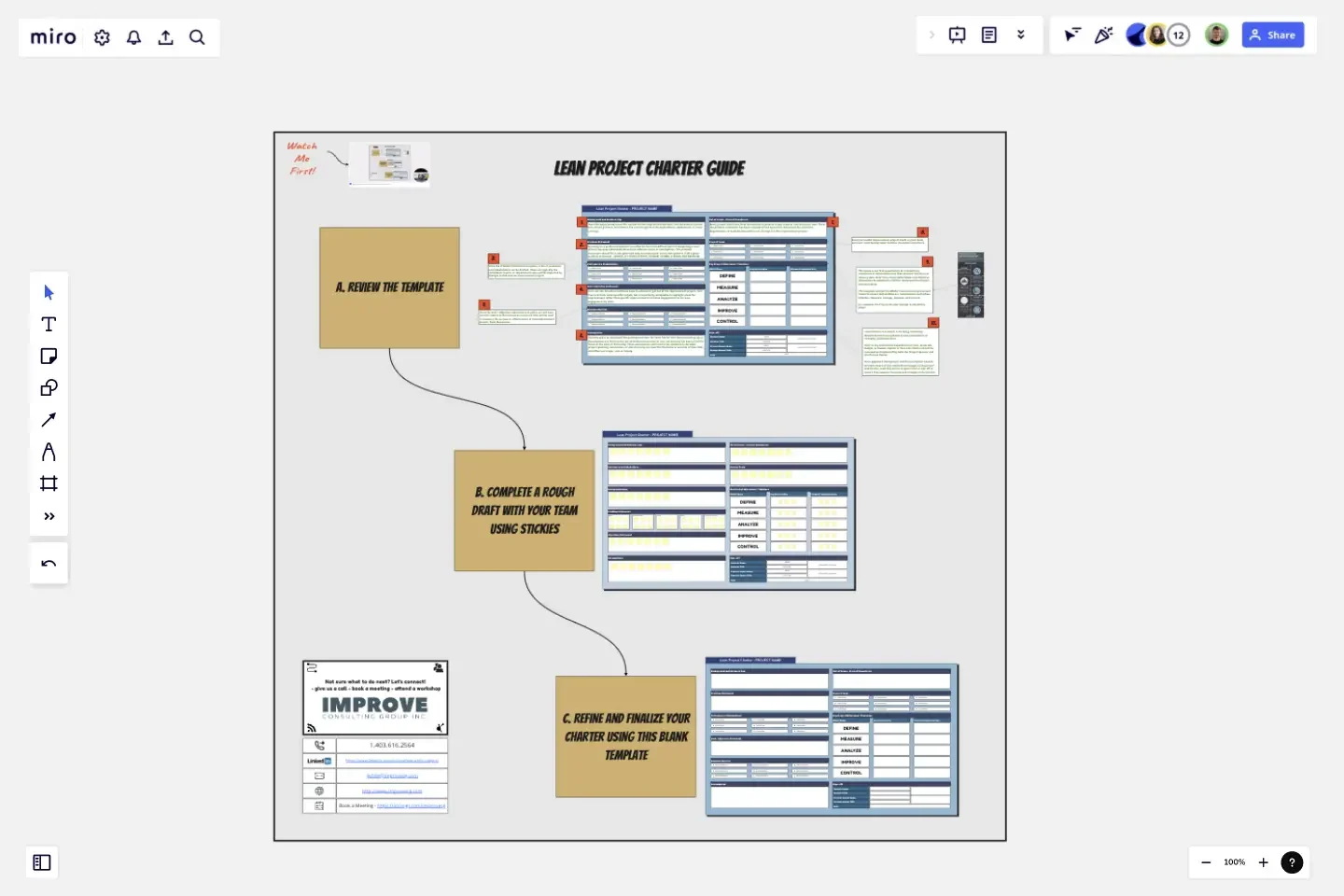Lean Project Charter
Project Charters are an essential element to any project, as they ensure the project team is able to describe all relevant project details.
About the template
The Lean Project Charter does all this in one easy space, and leveraging the power of Miro, you can now complete a charter with your team in no time and ensure everyone is on the same page for what we want to do, and how we will do it, and who needs to be involved.
This Miro submission includes an easy to follow three part template, with the first part introducing the 10 elements to this Lean Project Charter and a description for each element. This includes:
Background and Business Gap
Problem Statement
Customers and Stakeholders
Goals or Objective Statement
Business Metrics
Assumptions
Out of Scope or Project Boundaries
Project Team
Key Project Milestones and timelines
And Sign Off
Next, there is a brainstorming template complete with sticky notes so you and your team can get all of your ideas captured easily. And finally, there is a blank template where you can develop your final charter in preparation for sign off by the appropriate senior resources.
Get your team on the same page using the Lean Project Charter and you can collaboratively plan out your project activities while ensuring that you deliver exactly what was expected of your team.
This template was created by Hiro Studio.
Get started with this template right now.
Festival Retrospective
Works best for:
Retrospectives, Meetings, Agile Methodology
The Festival Retrospective template offers a unique and engaging approach to retrospectives by framing the session as a festive event. It provides elements for reflecting on past experiences, celebrating achievements, and setting goals for the future. This template enables teams to foster a positive and celebratory atmosphere, encouraging open communication and collaboration. By promoting a festive spirit, the Festival Retrospective empowers teams to strengthen bonds, boost morale, and drive continuous improvement effectively.
SIPOC Process Map
Works best for:
Agile Metodology
The SIPOC Process Map is a visual tool for documenting the high-level process flow of a system or project. It helps teams identify Suppliers, Inputs, Processes, Outputs, and Customers, facilitating a holistic understanding of the value stream. This template enables teams to visualize key process elements and interdependencies, empowering them to identify areas for improvement and optimize workflow efficiency. By promoting transparency and collaboration, the SIPOC Process Map empowers organizations to deliver value more effectively and satisfy customer needs.
Skill Cards
Works best for:
Agile
Skill Cards are a dynamic tool for assessing and developing skill sets within Agile teams. They provide a structured framework for reflecting on strengths, weaknesses, and learning goals, fostering a culture of continuous improvement. With Skill Cards, teams can identify skill gaps, distribute knowledge, and tailor professional development plans, empowering you to cultivate a high-performing team with diverse skill sets and shared expertise.
Scrum Puzzle Iteration Game
Works best for:
Agile, Games, Icebreaker
The Scrum Puzzle Iteration Game is a hands-on activity that reinforces Scrum principles and practices. By simulating iterative development cycles through puzzle-solving, teams learn the importance of collaboration, adaptability, and continuous improvement. This template provides a fun and engaging way to internalize Scrum concepts and enhance teamwork, empowering Agile practitioners to deliver value more effectively.
4Ps Retrospective
The 4Ps Retrospective template offers a structured framework for teams to reflect on past iterations or projects using the 4Ps model (Praise, Problems, Possibilities, and Plans). It provides elements for sharing positive feedback, identifying challenges, exploring opportunities, and setting action plans. This template enables teams to conduct retrospectives systematically, generate actionable insights, and drive continuous improvement. By promoting a balanced and comprehensive approach, the 4Ps Retrospective empowers teams to enhance collaboration, boost morale, and achieve their objectives effectively.
Start, Stop, Continue Retrospective by Laura Timmins
Works best for:
Retrospectives, Agile Methodologies
The Retrospective template offers a flexible and customizable framework for teams to reflect on past experiences and identify areas for improvement. It provides elements for sharing successes, challenges, and action items. This template enables teams to facilitate constructive discussions, generate insights, and drive continuous improvement. By promoting reflection and collaboration, the Retrospective empowers teams to optimize performance and achieve their goals effectively.
